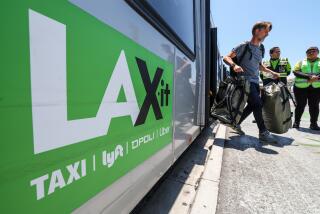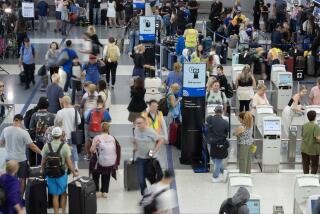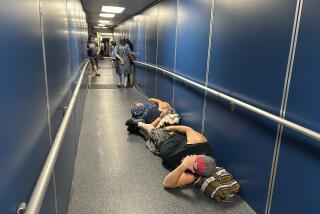LAX dry ice bombs: Police suspect airport workers, not terrorists
The investigation into a rash of dry-ice bombs found at Los Angeles International Airport is now being focused on airport workers and is not believed to be linked to terrorism.
All three devices were found in areas off-limits to the public, leading LAPD Chief Charlie Beck and other officials to concentrate on airport workers — particularly those with access to the tarmac.
“Whether you think this is a harmless prank or a way to disrupt operations at the airport, it won’t matter,” Beck said. “You will go to jail.”
The first device — a 20-ounce plastic bottle filled with dry ice — was discovered about 7 p.m. Sunday after it exploded in an employee-only restroom at Terminal 2, authorities said. No injuries were reported, but operations in the terminal were suspended and some flights delayed as the LAPD bomb squad cleared the scene.
More than 24 hours later, the LAPD was again notified after an airport employee found a plastic bottle that was fizzing — but had not exploded — on the tarmac outside the Tom Bradley International Terminal, officials said. The employee told police he had cleaned up a similar device on Sunday that had apparently exploded in the same area, LAPD Deputy Chief Michael Downing said. The employee said it wasn’t until he spotted the bottle Monday that he realized what it was.
Another potential dry-ice bomb — initially thought to be a fourth device — was found on the tarmac Monday, but it was determined to be trash, police said. LAPD officials initially offered conflicting reports about the number of devices found.
Investigators are examining the devices for fingerprints, DNA and other forensic evidence, LAPD Cmdr. Blake Chow said, and are reviewing surveillance video to see whether any of them contain footage of the suspect or suspects. Detectives are also interviewing airport workers and supervisors, he said.
Authorities are exploring several potential theories, sources said, including that the dry-ice bombs could be related to growing unrest on the tarmac after a longtime service provider was taken over by another corporation. But officials cautioned that until an arrest is made, they won’t know the motive.
The FBI is assisting with the investigation, and security has been increased at the airport.
Beck said the LAPD has also talked to airport officials about more closely “tracking the whereabouts” of dry ice, which he said “many, many” vendors used for food storage prior to loading food onto aircraft. Sources said vendors would regularly toss the dry ice in the trash and have been told to discontinue the practice.
When dry ice is placed inside a small, enclosed space — such as a plastic bottle — pressure builds as it turns from a solid into carbon dioxide, a gas. That pressure can eventually force the container to burst.
In May, a section of Disneyland was evacuated after two dry-ice bombs exploded in the Toontown area of the Anaheim theme park. A 22-year-old park employee was arrested and later pleaded not guilty to possessing a destructive device.
No one was seriously injured in the Disneyland blasts, though authorities said some people complained of ringing in their ears.
Paul Worsey, an explosives expert and professor at the Missouri University of Science and Technology, said it was unlikely a dry-ice device would do much damage.
“They’re really not a bomb, just a noise generator,” Worsey said. “It wouldn’t really be effective.”
Times staff writers Joel Rubin and Joseph Serna contributed to this report.
ALSO:
Five reputed gang members held in slaying of Santa Cruz boy, 12
Autopsy planned for Downey football player who collapsed on field
Explosions at LAX: Police ramp up security where dry ice bombs planted
More to Read
Sign up for Essential California
The most important California stories and recommendations in your inbox every morning.
You may occasionally receive promotional content from the Los Angeles Times.












